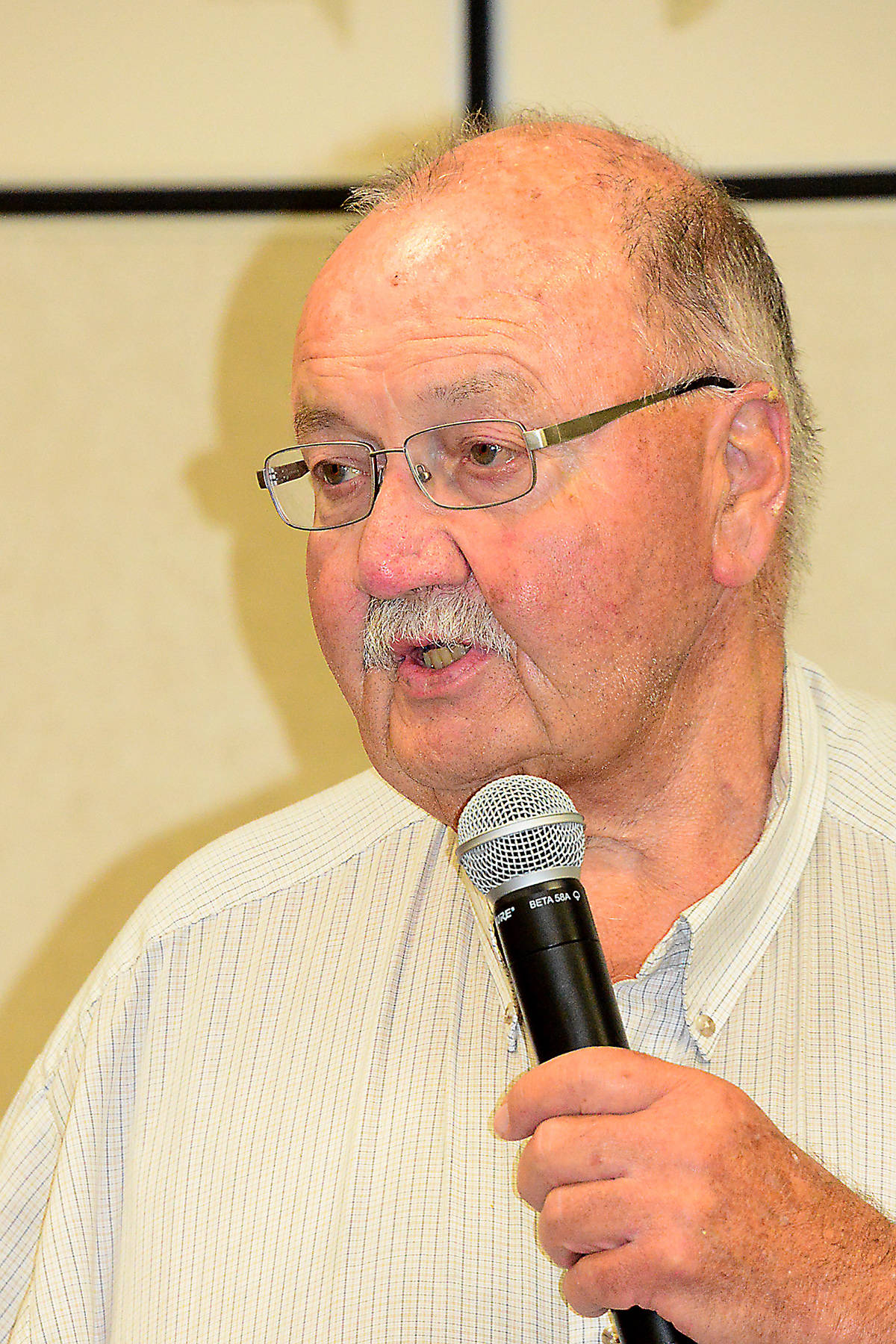BC Forest Service is bringing in one of the top incident management teams in the province to help with the fires near Little Fort, according to Cliff Chapman, deputy manager of the Kamloops Fire Centre.
“This is the best of the best that we have,” he told an information meeting held Sunday evening at Clearwater Secondary School.
The meeting was held primarily to update evacuees on what was going on. About 90 people attended, including evacuees plus a number of officials, volunteers and local residents interested in learning more about the present fire situation.
The audience included M.P. Cathy McLeod and newly-elected MLA Peter Milobar.
John Ranta, chair of the Thompson-Nicola Regional District, ran the meeting.
Chapman said he understood why people find the fire situation distressing.
“This was an unprecedented 24 hours for the BC Wildfire Service,” said the deputy manager of the Kamloops Fire Centre, referring to the fires that began Friday afternoon.
The Cariboo Fire Centre alone had over 80 starts reported, he said.
The fires near Little Fort are one of three major fire events in the Kamloops Fire Centre, he said, the others being Ashcroft and Cache Creek – the residents of both towns having been ordered evacuated.
Kamloops Fire Centre received its first reports of the Little Fort fires at about 4:30 on Friday afternoon.
There are three fires near Little Fort – one to the southwest near Thuya Lake Forest Service Road, the other two to the northeast. The latter two are expected to grow into one.
All three were about 50 hectares in size when the three-person Initial Attack crews were called. Needless to say, there was little the crews could do, other than call in air tanker runs.
The Kamloops Fire Centre deputy manager said he understands concerns that local logging contractors have not been fully engaged on the fires.
“You can’t have heavy equipment operating without supervision,” he said.
Once the incident management team gets established, those contractors who have registered and had the necessary training will be used, Chapman said.
“We are not holding back,” he said.
Incident manager gives synopsis
Jim Richardson, the incoming incident manager, said he arrived with a team of eight about three hours before the meeting and expected to have 16 within a few days.
He had already put in a request for 120 resources such as firefighters, heavy equipment and so on.
Their number one priority will be to protect lives and property such as buildings. Only after those are secure will they work to contain the fires.
Another priority will be to keep people informed through such things as bulletin boards and information meetings.
The incident management team is presently based out of the forests ministry office in Clearwater. However, he expected they would move into a camp soon.
He was a bit concerned because there was a cold front forecast to pass through the area Sunday night. However, he wasn’t overly concerned, as it was predicted to be weak, with winds of only 30 to 40 km/hr.
The biggest challenge would be the Thuya fire southwest of Little Fort, he felt. The steep terrain would make operations difficult and dangerous, he said.
Police have several roles
If there is an evacuation order or alert, the RCMP has the responsibility to let those affected know, said Cpl. Mark Labossiere of the Clearwater detachment.
Usually they make use of search and rescue volunteers or other resources going door-to-door, he said.
Police will usually be nearby while the doors are being knocked on, he said.
If people have concerns about those on their doorsteps, they should ask for identification or call the police, he advised.
An evacuation alert means get ready to go, he explained, while an evacuation order means leave almost immediately.
More police have arrived and are expected, Labossiere said.
There will be road blocks set up and roving patrols to protect the property of those evacuated.
“Please stay away from the evacuated areas for your own safety,” he asked.
For now, people from Little Fort who have been evacuated can return home to get belongings and so on, he said.
Keeping the highways open
With the increased traffic flow due to evacuations plus the closure of other highways, the Ministry of Transportation and Infrastructure is stepping up coverage by Commercial Vehicle Safety Enforcement, said Trent Folk, district manager for the Thompson-Nicola.
The coverage is targeting commercial vehicles, not evacuees, he said.
The extra enforcement is intended to help keep the highway open.
A fatal accident could keep Highway 5 closed for six to nine hours, one of the RCMP members attending pointed out.
The Ministry worked with BC Parks and RCMP to close a portion of Clearwater Valley Road as part of the closure of Wells Gray Park.
The best source of information on highway conditions and closures is www.drivebc.ca, he said. Coverage will be expanded to include side roads, although not forest service roads, Folk added.
Coordinating for emergencies
Primary responsibility for responding to emergencies or disasters lies with local governments, said Mike Knauff, regional manager for Emergency Management BC.
The role of his agency is to coordinate those responses and provide resources, he said.
The emergency operation centre (EOC) in Kamloops is open and fully staffed and, in fact, has been that way since the flooding in April.
Premier Christy Clark was in Kamloops on Sunday an announced $100 million to help those impacted by the fires.
Grant Gale, who is coordinating Emergency Social Service volunteers in Clearwater, asked about increasing the allowances for food vouchers given evacuees.
They haven’t been updated since 2009, he said.
“How can I feed someone breakfast for $10?” Gale asked.
When asked what preparations had been done to deal with a situation such as happened in 2003 when the only power-line into the North Thompson was cut, Knauff said it would be up to local governments to make plans. He also suggested home generators.
Mike Ranta recalled that following the power outage caused by the 2003 wildfires, the regional district had disposed of hundreds of freezers and refrigerators filled with spoiled food – only to be sued by the BC government for not disposing of the refrigerants properly. The suit was later dropped, Ranta said.
Fire departments guard riverbank
Volunteers from Little Fort Fire Department found two small spot fires that had jumped to the west side of the North Thompson River, reported Mike Savage, deputy chief of the Blackpool Fire Department.
That was on Friday, soon after the fires started.
Since then, firefighters from Blackpool and Clearwater to the north and Barriere and Little Fort to the south have patrolled along the river, looking for fires started on the west side. So far they have found nothing more, he said.
“If we find something, our goal is to knock it down before it comes up the valley,” Savage said.
The Barriere and Little Fort firefighters have also been patrolling in and around Little Fort, looking for spot fires and any other problems.
Monitoring health
Three groups are most at risk from smoke inhalation, said Dan Ferguson, manager for emergency management and enforcement with Interior Health.
Those are the elderly, pregnant women and people with respiratory problems such as asthma or COPD.
Special attention is given to four at-risk groups through home health services. These are people who can’t walk, people with mental health and/or drug addiction issues, people on kidney dialysis or similar problems, and women with at-risk pregnancies.
Interior Health would be responsible for evacuating Dr. Helmcken Memorial Hospital if there was an evacuation order in Clearwater, he said.
In fact, the policy is to begin evacuation at the alert stage and not wait for the order.
Evacuations of the hospitals in Ashcroft and 100 Mile House both began before the evacuation order came, he said.
Regional district and Red Cross help out
The Thompson-Nicola Regional District is taking the lead role in coordinating local governments’ response to events.
Her job is to interact with the information from experts and get it out to the public, said Debbie Sell, information officer with the TNRD’s emergency operations centre (EOC).
Evacuation alerts, orders and other information is available at the TNRD’s website and on its Facebook page, she said.
The EOC is staffed at most hours during the emergency and can be reached at 1-866-377-7188.
Clearwater’s Emergency Social Services (ESS) team is one of the best in the province, said Kayla Pepper, community planning and response coordinator with the Canadian Red Cross.
The team includes several people who went through the 2003 wildfires, she noted.
While it is not yet clear how the $100 million announced by Premier Christy Clark for evacuees will be distributed, it is important that those eligible be registered with the Red Cross.
Registration with ESS is not enough, she said.
People can register by calling 1-800-863-6582 or by going to www.redcross.ca/gethelp
Registration with the Red Cross also helps the government know where you are and that you are safe, and with family reunification, she pointed out.

